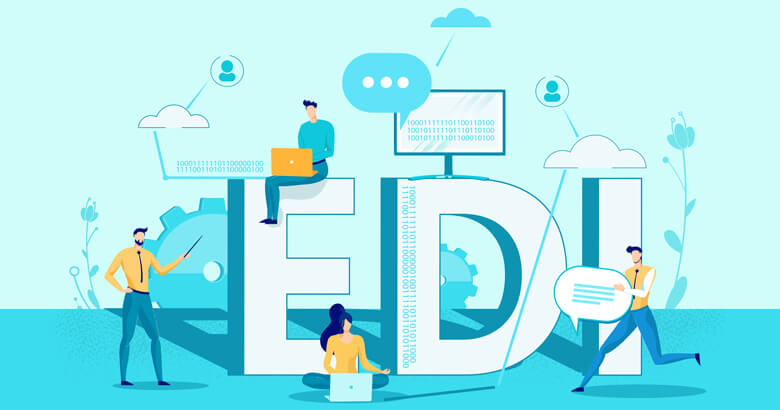What is EDI Compliance? Validating the Data Quality of your EDI Communication

EDI communication is an integral part of today’s business world. Whether B2B or B2G, invoices, orders, credit notes, forwarding orders and delivery slips are examples of documents which are now communicated by EDI straight from machine to machine. This data needs to be error-free, as when it arrives at your partner’s ERP system, it will be automatically processed to some extent. Many companies have even fully automated their ERP processing. EDI compliance is therefore crucial. What is EDI compliance? It’s ensuring that the data you send has the format and structure required by your business partner so that it can be processed with no unnecessary manual interventions. This is done by running EDI compliance checks to ensure the quality and validity of the data before it leaves your system. Data which contains errors is held by the system so that you can correct it.
Electronic Data Interchange, EDI for short, describes the digital exchange of business documents in a defined format between systems. So that the parties can automatically process the messages they receive, they have a detailed agreement to exchange their data based on standards such as UN/EDIFACT (United Nations Electronic Data Interchange For Administration, Commerce and Transport). In doing this, it is crucial to closely and constantly monitor and validate the data quality of the EDI messages. This needs doing long before the messages are sent, as well as during the exchange itself. For data quality and data validity are key to enabling an automated flow of business documents.
What is EDI compliance?
EDI compliance describes the ability to send and receive EDI messages (invoices, purchase orders, delivery bills) to a business partner’s specifications. Each document must be communicated in exactly the format specified by the recipient and comply with their business data rules. Most business to business partners have set out their requirements in EDI guidelines. If your business partner is the public sector, there are usually laws and regulations specifying their EDI requirements. This is the case for the German XRechnung (German only) format which is used for e-invoicing in the business to government (B2G) arena. These invoices need to comply with clearly defined legislation. You can use an online validators to ensure that invoices comply with the EDI regulations before they are sent to the debtor.
Each party needs to be able to convert into and from the EDI format to process the various documents within their own ERP system. Each partner therefore needs to ensure the EDI compliance of their data. What is EDI compliance? It’s checking that the syntax and semantics adhere to the national or industry-specific EDI standards your trading partners need to be able to work with the document.
Non-compliant EDI communication can cause real problems:
- It will interrupt operations for your business partner, which could lead to financial losses for the company. Consequences for you include late fees or chargebacks for non-compliant EDI communication.
- Correcting EDI errors requires manual intervention. This is more costly than an automated process. Furthermore, the measures taken to resolve the problem are often not documented. However, don’t forget that it is against the law to manipulate tax-relevant EDI documents.
- EDI errors are difficult to correct as they require high IT and process expertise. This means that fixing an EDI error often requires a full team of people.
What are classic EDI errors?
The agreements between two EDI partners are key in ensuring error-free EDI communication. If these are not closely adhered to, this may lead to errors in these two areas:
- Content errors
Content errors concern the data content of an EDI message. If some data doesn’t get transmitted, or more data is transmitted than agreed, this can cause errors for the recipient. It may however just be that the data is wrong. Maybe this is because of human error – a slip of the finger, or selecting the wrong record. There could be an issue in the master data. Dependant data, which are related to other records, are also a common cause for problems, such as a deviation in an amount. Equally, a recipient‘s incomplete data records may be at the root of a problem. - Technical errors
Technical errors concern the format and structure of the data. Errors may be present when the data is sent out, for example if the sender uses a different structure to that specified by the other party. Extra fields, missing fields or differently-labelled fields could all cause problems for the recipient. There can also be problems if the receiving party has made changes to their system and therefore required structure, yet has not told their business partners. This could have been avoided by brief, clear communication before the change went live. You can also avoid the costly technical errors described above by using an EDI validator to run compliance checks before sending.
EDI validators help to identify and avoid EDI message errors early on, before the message is sent. Depending on the focus of the compliance checks, these may scan for technical, structural and even some content errors. If they find an error, they notify the sender before the message is sent out, allowing him to intervene. However, the validator requires detailed specifications of a recipient’s requirements.
Brochure
SEEBURGER Console for simple document monitoring and target monitoring in SAP®.
(German only)
Thank you for your message
We appreciate your interest in SEEBURGER
Get in contact with us:
Please enter details about your project in the message section so we can direct your inquiry to the right consultant.
Written by: Marvin Döring
Marvin Döring is a consultant at econtea GmbH. He specialises in electronic invoicing (e-invoicing), electronic invoice validation and API integration. In 2016, after graduating in applied computer science in Stuttgart, he initially worked as a software engineer for toll collection. Always interested in creating and developing open source software, he has successfully turned one of his hobbies into his career. He also enjoys travelling, loves tenpin bowling and lets off steam on the badminton court.





